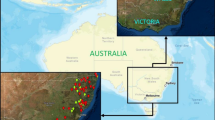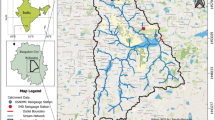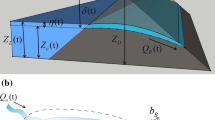Abstract
The use of rainfall–runoff models constitutes an alternative to statistical approaches (such as at-site or regional flood frequency analysis) for design flood estimation and represents an answer to the increasing need for synthetic design hydrographs associated with a specific return period. Nevertheless, the lack of streamflow observations and the consequent high uncertainty associated with parameters estimation usually pose serious limitations to the use of process-based approaches in ungauged catchments, which in contrast represent the majority in practical applications. This work presents a Bayesian procedure that, for a predefined rainfall–runoff model, allows for the assessment of posterior parameters distribution, using limited and uncertain information available about the response of ungauged catchments, i.e. the regionalized first three L-moments of annual streamflow maxima. The methodology is tested for a catchment located in southern Italy and used within a Monte Carlo scheme to obtain design flood values and simulation uncertainty bands through both event-based and continuous simulation approaches. The obtained results highlight the relevant reduction in uncertainty bands associated with simulated peak discharges compared to those obtained considering a prior uniform distribution for model parameters. A direct impact of uncertainty in regional estimates of hydrological signatures on posterior parameters distribution is also evident. For the selected case study, continuous simulation, generally, better matches the estimates of the statistical flood frequency analysis.











Similar content being viewed by others
References
Alfieri L, Laio F, Claps P (2008) A simulation experiment for optimal design hyetograph selection. Hydrol Process 22:813–820
Almeida S, Bulygina N, McIntyre N, Wagener T, Buytaert W (2012) Predicting flows in ungauged catchments using correlated information sources. BHS National Symposium Proceedings, Dundee
Aronica GT, Candela A (2007) Derivation of flood frequency curves in poorly gauged Mediterranean catchments using a simple stochastic hydrological rainfall-runoff model. J Hydrol 347(1–2):132–142
Biondi D, Claps P, Cruscomagno F, De Luca DL, Fiorentino M, Ganora D, Gioia A, Iacobellis V, Laio F, Manfreda S, Versace P (2012) Dopo il VAPI: la valutazione delle massime portate al colmo di piena nell’esperienza del POR Calabria (in Italian). In: Proceedings of XXXIII Italian national conference on hydraulics and hydraulic engineering, Brescia, Italy, 10–15 September 2012
Blazkova S, Beven KJ (2002) Flood frequency estimation by continuous simulation for a catchment treated as ungauged (with uncertainty). Water Resour Res. doi:10.1029/2001WR000500
Blazkova S, Beven K (2009) A limits of acceptability approach to model evaluation and uncertainty estimation in flood frequency estimation by continuous simulation: Skalka catchment, Czech Republic. Water Resour Res 45: W00B16
Blöschl G, Sivalapan M, Wagener T, Viglione A, Savenije H (2013) Runoff prediction in ungauged basins. Synthesis across processes, places and scales. Cambridge University Press, Cambridge
Boughton W, Droop O (2003) Continuous simulation for design flood estimation—a review. Environ Modell Softw 18(49):309–318
Box G, Tiao G (1973) Bayesian inference in statistical analysis. Addison-Wesley, Reading
Bulygina N, McIntyre N, Wheater HS (2009) Conditioning rainfall-runoff model parameters for ungauged catchments and land management impacts analysis. Hydrol Earth Syst Sci 13:893–904. doi:10.5194/hess-13-893-2009
Bulygina N, McIntyre N, Wheater H (2011) Bayesian conditioning of a rainfall-runoff model for predicting flows in ungauged catchments and under land use changes. Water Resour Res 47:W02503. doi:10.1029/2010WR009240
Bulygina N, Ballard C, McIntyre N, O’Donnell G, Wheater H (2012) Integrating different types of information into hydrological model parameter estimation: application to ungauged catchments and land use scenario analysis. Water Resour Res. doi:10.1029/2011WR011207
Cameron D, Beven K, Tawn J, Blazkova S, Naden P (1999) Flood frequency estimation by continuous simulation for a gauged upland catchment (with uncertainty). J Hydrol 219:169–187. doi:10.1016/S0022-1694(99)00057-8
Cameron D, Beven K, Naden P (2000) Flood frequency estimation under climate change (with uncertainty). Hydrol Earth Syst Sci 4(3):393–405
Castiglioni S, Lombardi L, Toth E, Castellarin A, Montanari A (2010) Calibration of rainfall-runoff models in ungauged basins: a regional maximum likelihood approach. Adv Water Resour 33(10):1235–1242
Claps P, Laio F (2008). Aggiornamento delle procedure delle procedure di valutazione delle piene in Piemonte, con particolare riferimento ai bacini sottesi da invasi artificiali. VOLUME I: Costruzione e applicazione delle procedure di stima delle portate al colmo di piena (in Italian). Technical report of Department of Hydraulics, Transport and Civil Infrastructures, Polytechnic of Turin, 306 pp
Claps P, Fiorentino M, Sole A, Iacobellis V, Laio F, Manfreda S, Margiotta MR (2010). Attività A Livello 2:Modelli statistici regionali (in italian). Technical report of the Project POR-Calabria 2000–2006 “Studio e sperimentazione di metodologie e tecniche per la mitigazione del rischio idrogeologico”. July 2010
De Luca DL (2014) Analysis and modelling of rainfall fields at different resolutions in southern Italy. Hydrol Sci J 59(8):1536–1558. doi:10.1080/02626667.2014.926013
De Michele C, Salvadori G (2002) On the derived flood frequency distribution: analytical formulation and the influence of antecedent soil moisture condition. J Hydrol 262:245–258
de Paola F, Ranucci A, Feo A (2013) Antecedent moisture condition (SCS) frequency assessment: a case study in southern Italy. Irrig Drain 62:61–71. doi:10.1002/ird.1801
Eagleson PS (1972) Dynamics of flood frequency. Water Resour Res 8(4):878–898
Efstratiadis A, Koussis AD, Koutsoyiannis D, Mamassis N (2014) Flood design recipes vs. reality: Can predictions for ungauged basins be trusted? Nat Hazard Earth Sys 14(6):1417–1428. doi:10.5194/nhess-14-1417-2014
Griffis VW, Stedinger JR (2007) The use of GLS regression in regional hydrologic analyses. J Hydrol 344:82–95
Grimaldi S, Petroselli A, Serinaldi F (2012a) A continuous simulation model for design-hydrograph estimation in small and ungauged watersheds. Hydrolog Sci J 57(6):1035–1051. doi:10.1080/02626667.2012.702214
Grimaldi S, Petroselli A, Serinaldi F (2012b) Design hydrograph estimation in small and ungauged watersheds: continuous simulation method versus event-based approach. Hydrol Process 26:3124–3134. doi:10.1002/hyp.8384
Grimaldi S, Petroselli A, Romano N (2013) Green-Ampt curve-number mixed procedure as an empirical tool for rainfall-runoff modelling in small and ungauged basins. Hydrol Process 27(8):1253–1264. doi:10.1002/hyp.9303
Gupta HV, Wagener T, Liu Y (2008) Reconciling theory with observations: elements of a diagnostic approach to model evaluation. Hydrol Process 22:3802–3813. doi:10.1002/hyp.6989
Hrachowitz M, Savenije HHG, Blöschl G, McDonnell JJ, Sivapalan M, Pomeroy JW, Arheimer B, Blume T, Clark MP, Ehret U, Fenicia F, Freer JE, Gelfan A, Gupta HV, Hughes DA, Hut RW, Montanari A, Pande S, Tetzlaff D, Troch PA, Uhlenbrook S, Wagener T, Winsemius HC, Woods RA, Zehe E, Cudennec C (2013) A decade of Predictions in Ungauged Basins (PUB)—a review. Hydrolog Sci J 58(6):1198–1255. doi:10.1080/02626667.2013.803183
Joe H (1997) Multivariate models and dependence concepts. Chapman & Hall, New York
Kjeldsen TR (2007) The revitalised FSR/FEH rainfall-runoff method—a user handbook, Flood Estimation Handbook Supplementary Report No. 1, Centre for Ecology and Hydrology, Wallingford. www. ceh.ac.uk/refh
Laio F, Ganora D, Claps P, Galeati G (2011) Spatially smooth regional estimation of the flood frequency curve (with uncertainty). J Hydrol 408:67–77
Lamb R (1999) Calibration of a conceptual rainfall-runoff model for flood frequency estimation by continuous simulation. Water Resour Res 35(10):3103–3114. doi:10.1029/1999WR900119
Lamb R (2006) Rainfall-runoff modeling for flood frequency estimation. Encycl Hydrol Sci 11:125
Lombardi L, Toth E, Castellarin A, Montanari A, Brath A (2012) Calibration of a rainfall–runoff model at regional scale by optimising river discharge statistics: Performance analysis for the average/low flow regime. Phys Chem Earth 42–44:77–84
Loukas A (2002) Flood frequency estimation by a derived distribution procedure. J Hydrol 255(1–4):69–89
Menabde M, Sivapalan M (2000) Modeling of rainfall time series and extremes using bounded random cascades and levystable distributions. Water Resour Res 36(11):3293–3300. doi:10.1029/2000WR900197
Merz R, Bloschl G (2004) Regionalisation of catchment model parameters. J Hydrol 287(95–123):2004. doi:10.1016/j.jhydrol.2003.09.028
Michel C, Andréassian V, Perrin C (2005) Soil conservation service curve number method: How to mend a wrong soil moisture accounting procedure? Water Resour Res. doi:10.1029/2004WR003191
Molnar P, Burlando P (2005) Preservation of rainfall properties in stochastic disaggregation by a simple random cascade model. Atmos Res 77:137–151. doi:10.1016/j.atmosres.2004.10.024
Montanari A, Toth E (2007) Calibration of hydrological models in the spectral domain: an opportunity for ungauged basins? Water Resour Res 43:W05434. doi:10.1029/2006WR005184
Montgomery DC, Peck EA, Vining GG (2001) Introduction to linear regression analysis, 3rd edn. Wiley, New York. ISBN: 10:0471315656
Moretti G, Montanari A (2008) Inferring the flood frequency distribution for an ungauged basin using a spatially distributed rainfall-runoff model. Hydrol Earth Syst Sci 12:1141–1152. doi:10.5194/hess-12-1141-2008
Nash JE (1957) The form of instantaneous unit hydrograph. Int Assn Sci Hydro Publ No. 51: 546-557, IAHS, Gentbrugge
Nelsen RB (2006) An introduction to Copulas, 2nd edn. Springer, New York
Pathiraja S, Westra S, Sharma A (2012) Why continuous simulation? The role of antecedent moisture in design flood estimation. Water Resour Res 48:W06534. doi:10.1029/2011WR010997
Reis DS Jr, Stedinger JR, Martins ES (2005) Bayesian generalized least squares regression with application to log Pearson type 3 regional skew estimation. Water Resour Res 41:W10419. doi:10.1029/2004WR003445
Rogger M, Kohl B, Pirkl H, Viglione A, Komma J, Kirnbauer R, Merz R, Blöschl G (2012) Runoff models and flood frequency statistics for design flood estimation in Austria—Do they tell a consistent story? J Hydrol 456–457:30–43
Rossi F, Fiorentino M, Versace P (1984) Two-component extreme value distribution for flood frequency analysis. Water Resour Res 20(7):847–856
Saghafian B, Ghasemi AR, Golian S (2014) Flood frequency analysis based on simulated peak discharges. Nat Hazards 71:403–417
Salvadori G, De Michele C, Kottegoda NT, Rosso R (2007) Extremis in nature An approach using Copulas Water science and technology library, vol 56. Springer, Berlin
Seibert J (1999) Regionalisation of parameters for a conceptual rainfall runoff model. Agric For Meteorol 98–99:279–293
Serinaldi F (2009) A multisite daily rainfall generator driven by bivariate copula-based mixed distributions. J Geophys Res 114:D10103. doi:10.1029/2008JD011258
Sharma A, Mehrotra R (2010) Rainfall generation. American Geophysical Union, pp 215–246. doi:10.1029/2010GM000973
Sirangelo B, Versace P, De Luca DL (2007) Rainfall nowcasting by at site stochastic model P.R.A.I.S.E. Hydrol Earth. Syst Sci 11(4):1341–1351
Sivapalan M (2003) Prediction in ungauged basins: a grand challenge for theoretical hydrology. Hydrol Process 17:3163–3170. doi:10.1002/hyp.5155
Stedinger J, Tasker G (1985) Regional hydrologic analysis: 1. Ordinary, weighted, and generalized least squares compared. Water Resour Res 21(9):1421–1432. doi:10.1029/WR021i009p01421
USDA, SCS (1964) National engineering handbook, Sec. 4 Hydrology. USDA, Washington, DC
Verhoest NEC, Vandenberghe S, Cabus P, Onof C, Meca-Figueras T, Jameleddine S (2010) Are stochastic point rainfall models able to preserve extreme flood statistics? Hydrol Process 24:3439–3445
Viglione A, Bloschl G (2009) On the role of storm duration in the mapping of rainfall to flood return periods. Hydrol Earth Syst Sci 13:205–216
Viviroli D, Mittelbach H, Gurtz J, Weingartner R (2009) Continuous simulation for flood estimation in ungauged catchments of Switzerland—Part II: parameter regionalisation and flood estimation results. J Hydrol 377:208–225
Wagener T, Montanari A (2011) Convergence of approaches toward reducing uncertainty in predictions in ungauged basins. Water Resour Res 47:W06301. doi:10.1029/2010WR009469
Wheater H, Chandler R, Onof C, Isham V, Bellone E, Yang C, Lekkas D, Lourmas G, Segond ML (2005) Spatial-temporal rainfall modelling for flood risk estimation. Stoch Environ Res Risk Assess 19(6):403–416
Winsemius HC, Schaefli B, Montanari A, Savenije HHG (2009) On the calibration of hydrological models in ungauged basins: a framework for integrating hard and soft hydrological information. Water Resour Res 45:W12422. doi:10.1029/2009WR007706
Yadav M, Wagener T, Gupta HV (2007) Regionalization of constraints on expected watershed response behavior. Adv Water Resour 30:1756–1774. doi:10.1016/j.advwatres.2007.01.005
Author information
Authors and Affiliations
Corresponding author
Rights and permissions
About this article
Cite this article
Biondi, D., De Luca, D.L. Process-based design flood estimation in ungauged basins by conditioning model parameters on regional hydrological signatures. Nat Hazards 79, 1015–1038 (2015). https://doi.org/10.1007/s11069-015-1889-1
Received:
Accepted:
Published:
Issue Date:
DOI: https://doi.org/10.1007/s11069-015-1889-1




